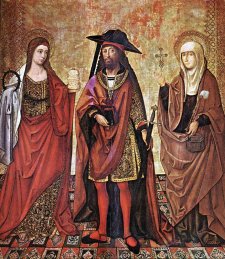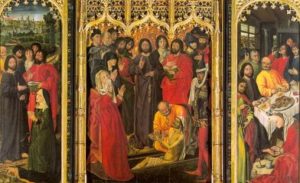Day 2: Christ in the House of Martha & Mary, by Tintoretto
Art: We believe that Mary Magdala and Mary of Bethany were the same person. Martha and the Magdala were therefore sisters. Their personalities were very different–Martha was more practical, Mary more spiritual. But their bond was evidently strong, because Martha is portrayed as going with Mary to France after Yeshua’s resurrection. The two sisters were often painted together with Lazarus as seen below.
Devotional: What kind of sister was Mary Magdala? How did her sisterly role change over the years? In what ways does she express her”sisterhood” to you? Meditate on the role of Mary Magdala as a type of “universal sister”. How does this change your attitude toward her?
Mysteries & Symbols: This is one of my favorites. On one occasion when Margaret Starbird showed this painting to a crowd of people,a woman who happened to be a certified midwife said, “Hey, she’s on a birthing stool and is even in the birthing position!” I showed it to a group on Magdalene’s feast day 2005 which included two midwives, one of which is now a dear friend and neighbor, Debbie Dise. She agreed completely.
Other fascinating symbols in this painting are: 1. The X’s in the window glass 2. The complementary clothing MM and Yeshua are wearing — exactly opposite each other, which coupled with their yin-yang body positions makes them look like the yin-yang symbol of sacred opposites, masculine and feminine. 3. Most fascinating of all is Yeshua’s hand position. He is making the sign of the Vesica Piscis! There it is again, that Vesica Piscis which has the number 154, same as the gematria value of “the Magdalene”. The symbol of the Vesica Piscis instantly indicated the goddess to anyone living in the ancient world, and there are several paintings, including another one in this 15 day series, where someone is making the sign with their hands. Wow,what risks these painters took — their very lives were at stake from the Inquisition, but still they bravely included heretical symbols so that generations to come might “remember” or discover the secret knowledge.

Christ in the House of Martha and Mary
by Tintoretto 1570-75
Oil on canvas, 200 x 132 cm
Alte Pinakothek, Munich
Below are other Paintings showing Magdalene with Martha and Lazarus of Bethany,suggesting they were a siblings and therefore Magdalene and Mary of Bethany are the same woman. This was official church teaching for 1500 years until 1969 when the Roman Catholic Church decided to change their mind and say the two Marys are separate women. The Eastern Orthodox Church and the Protestants have always taught they were separate women, but the evidence is high they were one and the same. You might ask, how can this Mary wife be from two towns, both Bethany and Magdala. But remember, Magdala’s title, “the Magdalene” means Mary the Great, or Tower of the Flock, it is not the name of a town. There is indeed a fishing village near Cana named Migdala or Magdala, but it didn’t exist during Mary and Jesus’ day. It is my view that she was born Mary of Bethany but found her calling,so to speak, and became the first lady of Christianity, Mary the Great (the Magdalene or Magdala).

St Lazarus between Martha and Mary, by Unknown Spanish painters (year unknown)Panel Museo Lázaro Galdiano, Madrid

Martha Rebuking Mary for Vanity, by Cagnacci, 1660. In my opinion,this is just a fantasy of Cagnacci’s based on the false claims Magdalene was a prostitute. It is so beautifully painted that it has survived! I include it because it shows Mary of Bethany (being rebuked here by Martha of Bethany) and Mary Magdalene were believed to be the same woman.

Triptych showing Lazarus and Mary Magdalene by Nicolas Froment, 1461. Notice Mary Magdalene and Mary of Bethany are portrayed as the same woman in this triptych (three-panel painting). On the left we see Mary of Bethany when she tells Yeshua, “If only you had been here,Lazarus wouldn’t have died.” She is wearing green, clearly a Magdalene color. In the next two panels she is in red, very very clearly a Magdalene color and indicating the painter is saying she is the Magdalene. The middle panel shows Magdalene/Mary of Bethany at the raising of Lazarus her brother. Note how she looks pregnant.
The third panel shows Mary of Bethany/Magdalene anointing Yeshua’s feet at the famous banquet-table scene. The Gospel of John specifically names the anointress as Mary of Bethany (in chapters 11 and 12 there is one verse each that names her). In both Matthew and Mark, Jesus says that her anointing act is part of the sacred burial and resurrection ritual. He also fortells that people will forever speak of her action: “wherever in the world this gospel reaches, what she has done will be told in memory of her.” But John is the only gospel that names the anointress as Mary of Bethany. Then later in John’s gospel, John has Magdalene go to the tomb alone to anoint Yeshua again and discover his resurrection (in a garden). This is exactly in keeping with the ancient sacrificed bridegroom and bride priestess fertility rites of the ancient world because only the priestess who had anointed him previously could resurrect him, sort of “call” him back. So John was subtely telling us that Mary of Bethany and Mary Magdalene were the same woman. Our ancient ancestors would have instantly recognized Magdalene and Yeshua as fulfilling the sacred archetypal couple, their familiar annual dying and resurrecting god/goddess pair.
Easy Lab Report Form
Contemplation Lab MainPage
1 2 3 4 5 6 7 8 9 10 11 12 13 14 15

